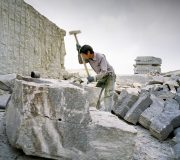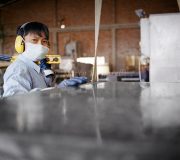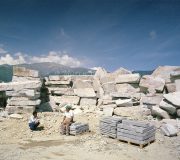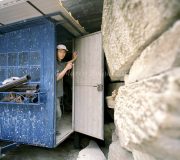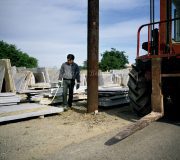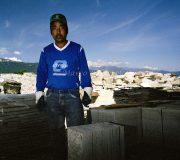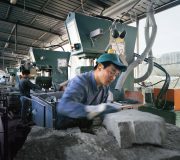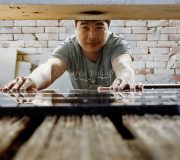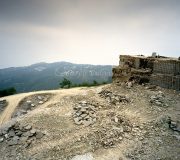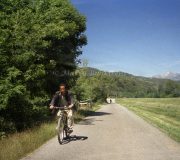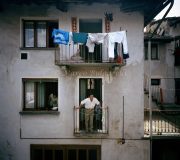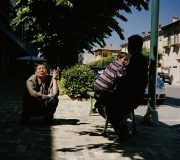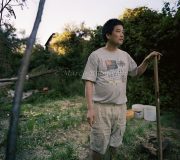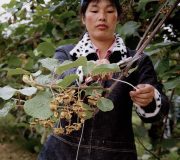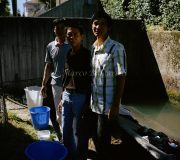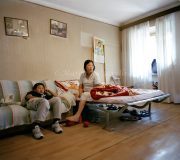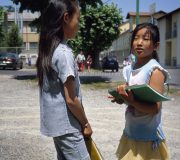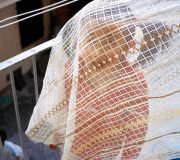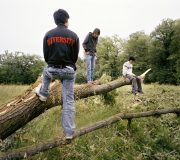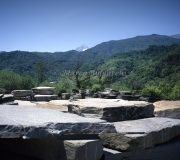Chinese stonemasons
Passing through the Infernotto’ s Valley the Monviso majestic top covered by snow captures your sight, making You look away for just a few seconds before a rather strange scenery.
Dozens of Chinese coming towards you on bicycles. The question is: Where do they come from? But most of all what do they do here in the north of Italy in the region of Piemonte?
It all started around the second part of the nineties. The rapid and increasing demand for manpower to be used for the extraction and processing of the local “grey gold”, Luserna stone*, becomes an attractive factor for the massive number of Chinese immigrants that start to arrive, many of them illegally, in this part of Italy.
Hundreds of trucks come down every day along the main road, full of blocks of stone that have just been extracted from the nearby caves of Barge and Bagnolo. They go directly from the source to the various firms specialized in carving. There you find a high percentage of Chinese employed as stonecutters, a typical activity of their own territory of origin, a job nowadays not considered anymore by the young Italian generation.
We enter a warehouse and surrounded by deafening noise and clouds of white dust we encounter a worker, after taking off his gloves, mask and cap introduce himself. His name is Yuguo, a Chinese immigrant, 45 years old, who arrived at Berge in 1998, when working in this part of Italy was guaranteed and the Turco-Napolitano law gave immigrants the possibility to get regularized. Yuguo’s choice had been the same as many other Chinese immigrants, in fact, today the percentage of Chinese citizens in the two towns of the Cuneo district amounts to about 10% of the overall population. Very hard to find such a high percentage in other parts of Italy.
“ Here we are all employs, Chinese haven’t opened their own firms, only maybe 6 or 7, because it is very difficult to get authorizations to extract the stone, and those who work by themselves receive orders from Italians.”
This is a completely different situation considering the various historically known places of Chinese immigration in Italy, such as Prato or Milan, where the Chinese immigrants have become entrepreneurs and have expanded especially in the textile industry. On one side it has been a hard choice due to the difficulties of the work itself, but on the other side, it has given them major economic stability compared to the ones that have decided to work on their own.
The question at this point is obvious “who was the first Chinese to arrive in this part of the region?”.
We met him at the market, his name is Lunquiao, better known as Franco.
“I arrived in 1994. I was in Milan when by chance I saw some Italian workers fixing the paving of a square. I was curious because in China I used to do the same job. So I asked for some information and I found myself here with some addresses of employers…”
Contrary to popular belief, there has been no kind of “organization” that managed the newly arriving workforce, but just a so-called social phenomenon is known as the migration chain, where parents and friends just gave word to each other. As today the job market is saturated and therefore there have not been new arrivals, with the exception of the reunification of families.
Many families after years of hard work and putting away their savings have moved to bigger cities where they have succeeded in opening a bar or a shop on their own.
Women on the other side have not succeeded in making it through the tight work texture. They found jobs such as season workers for the picking and choosing of fruits or as general workers in some industries far from home. “For us, it is very hard to find a job. The public transportation used to move around the territory are not sufficient but the biggest problem is the language, we don’t speak Italian. “ tells us Xiaohua, meanwhile trimming Kiwi plants in a field.
Where do all these Chinese come from?
The majority of the Chinese immigrants that live in the two Cuneo districts, as almost all the Chinese in Italy, come from a precise area in the hinterland of the province of Southern Zhejiang, South of Shanghai, in an area of about 70 kilometers of diameter. Precisely in the districts of Wencheng and Qingtian, where there are only small mountain villages.
With her class register in her hands, a teacher of an elementary school of Barge calls out loud the names of “ Jianhua…Liqing…Chengxian…”. Also in the schools of the two small Cuneo districts, it is possible to verify the result of this immigration.
In a few years Chinese students have become the 25% of the total number of students, about 5 or 6 per class, which gave the Italian teachers extra work to do: find new didactic ways to help them learn Italian and create a serene living together with the Italian schoolmates of their same age.
Obviously, it has not been simple and problems have come up, especially after grammar school, this can be seen by the high percentage of school abandonment. Only time will be able to reduce this trend. Chinese student parents have demonstrated a lot of trust in the Italian school and often they insist that their sons and daughters get failed many times to improve their Italian.
Walking along we run into Youbo, his face has the clear signs of many not sleeping nights, he tells us he has just returned from Milan, where he went with his family for three days for the celebrations for the wedding of one of his cousins. Marriages together with new years moon day are the most important festivities to be passed with parents and friends, and distances are never a big problem. On the other side, social life in Barge and Bagnolo isn’t of great interest, and during their spare time, they cultivate their small vegetable garden or visit friends where card games can go on for days.
The young generation goes to Milan or Turin during weekends. Liyou, a young boy aged 17, explains to us that “ there we can find Chinese discothèques while here there is nothing to do”.
There are no particular meeting places, except maybe the Bagnolo P.te washhouse, an abandoned place restored by the Chinese community. We go there on Sundays afternoon and find a lot of people washing their clothes. The interest we have in them at first creates a rather tense atmosphere but in a short while everybody starts to laugh.
We also find them at the Consorzio Monviso Solidale, a local board that manages social security services in the Cuneo’s district, at the counter for public services and professional advice for immigrants. Inside it is a continuous coming and going of Chinese of different ages. Some of them are there to renew the resident's permit or show a medical prescription to have an explanation on the use of the medicine.
Yuguo invites us to his house, and as soon as he opens the front door a small girl named Lisa jumps on his lap calling him Zio her acquired uncle and also the referent and translator of the counter for the public services and professional advices at the Consorzio Monviso Solidale.
In the courtyard there is the everyday life of a sinobargese: kids playing, clothes that hang out along all the balconies, and various hard-to-define vegetables put out to dry. We get in the house and meanwhile, Yuguo shows us the photos of his marriage, Yuelan, his wife, is in the kitchen cutting cabbage, and minces pig meat and shows us with pride jiucai, a kind of Chinese onion herb that they grow in a small garden just behind their house. Just after 5 minutes on the table arrives an enormous plate full of Chinese spring rolls, and while eating them Yuelan explains to us that “the ones they give you in the Chinese restaurants aren’t that good because they don’t have the jiucai!”. We talk about how they live here in Barge and after a few minutes of silence Yuguo surprises us by saying in perfect Italian “There are too many Chinese!”

